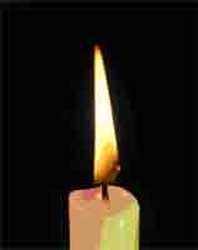CANDLE SAFETY
Remember that a candle is an open flame. It can easily ignite any combustible nearby.
Facts and Figures
Safety Tips:
Facts and Figures
- During 2002, an estimated 18,000 home fires started by candles were reported to public fire departments. These fires resulted in an estimated 130 civilian deaths, 1,350 civilian injuries and an estimated direct property loss of $333 million. Homes include one- and two-family dwellings, apartments and manufactured housing.
- The estimated number of home candle fires was unchanged from 2001 to 2002. For the first time since 1991, the number of home candle fires has stabilized rather than increasing.
- Candle fires accounted for an estimated 5% of all reported home fires.
- Two-fifths (40%) of the home candle fires started in the bedroom, resulting in 30% of the associated civilian deaths.
- Reported home candle fires have more than tripled since the low of 5,500 in 1990.
- December had almost twice the number of home candle fires of an average month.
- Half (50%) of home candle fires occurred when some form of combustible material was left or came too close to the candle; Source: National estimates based on NFIRS and NFPA survey.
- 18% percent occurred after candles were left unattended, abandoned or inadequately controlled; Five percent were started by people (usually children) playing with the candle.
- Falling asleep was a factor in 12% of home candle fires and 25% of the home candle fire deaths.
- Christmas Day was the peak day of the year for home candle fires in 1999-2002. New Year's Day and Christmas Eve tied for second.
Safety Tips:
- Extinguish all candles when leaving the room or going to sleep.
- Keep candles away from items that can catch fire, like clothing, books and curtains.
- Use candle holders that are study, won't tip over easily, are made from a material that cannot burn, and are large enough to collect dripping wax.
- Keep candles and all open flames away from flammable liquids.
- Keep candle wicks trimmed to one-quarter inch and extinguish taper and pillar candles when they get to within two inches of the holder. Votives and containers should be extinguished before the last half-inch of wax starts to melt.
- During power outages, avoid carrying a lit candle. Use flashlights.

